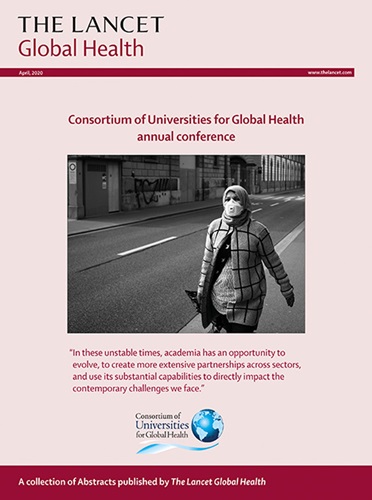The effect of BCG revaccination on the response to unrelated vaccines in urban Ugandan adolescents (POPVAC C): an open-label, randomised controlled trial.
IF 19.9
1区 医学
Q1 PUBLIC, ENVIRONMENTAL & OCCUPATIONAL HEALTH
引用次数: 0
Abstract
BACKGROUND Immune responses induced by several important vaccines differ between populations, with reduced responses in low-income and rural settings compared with high-income and urban settings. BCG immunisation boosts immune responses to some unrelated vaccines in high-income populations. We aimed to test the hypothesis that BCG revaccination can enhance responses to unrelated vaccines in Ugandan schoolchildren. METHODS We conducted an open-label, randomised controlled trial to compare the effects of BCG revaccination versus no BCG revaccination on the immunogenicity of subsequent unrelated vaccines among adolescents aged 13-17 years who are participants in an urban Ugandan birth cohort study, in which BCG vaccination was documented at birth. Participants were excluded if they had received any of the trial vaccines or related agents when aged 5 years or older. Computer-generated 1:1 randomisation was implemented in REDCap. Participants were excluded if they were concurrently enrolled in other trials; had a clinically significant history of immunodeficiency, or serious psychiatric conditions or moderate to severe acute illnesses; were taking immunosuppressive medications; had allergies to vaccine components, a predisposition towards developing keloid scarring; positive HIV tests or pregnancy tests; were female participants who were lactating; or if they planned to use investigational drugs, vaccines, blood products, or any combination thereof. Trial participants assigned to the BCG revaccination group received the live parenteral BCG-Russia vaccine (Serum Institute of India, Pune, India; 0·1 mL intradermally, right upper arm) at week 0. All participants received yellow fever vaccine (YF-17D; Sanofi Pasteur, Lyon, France; 0·5 mL intramuscularly, left upper arm), live oral typhoid vaccine (Ty21a; PaxVax, London, UK; one capsule per day taken for three alternate days), and quadrivalent virus-like particle human papillomavirus (HPV) vaccine (Merck, Rahway, NJ, USA; 0·5 mL intramuscularly, left upper arm) at week 4; and toxoid vaccines (tetanus-diphtheria; Serum Institute of India; 0·5 mL intramuscularly, left upper arm) and an HPV booster at week 28. An additional HPV vaccination at week 8 was provided to female participants older than 14 years who had not previously been vaccinated. The primary outcomes were yellow fever neutralising antibody titres at 4 weeks post-YF-17D vaccination, Salmonella enterica serovar Typhi (henceforth S Typhi) O-lipopolysaccharide (O:LPS)-specific IgG concentration at 4 weeks post-Ty21a vaccination, and HPV-16 and HPV-18 L1 protein-specific IgG concentration at 4 weeks post-HPV vaccination. Primary outcome assays were conducted at week 8, and at week 52 for tetanus-diphtheria. We conducted an intention-to-treat analysis comparing log-transformed outcomes between trial groups, with results back-transformed to geometric mean ratios (GMRs). The safety population comprised all randomly allocated participants. The trial was registered at the ISRCTN Registry (ISRCTN10482904) and is complete. FINDINGS Between Aug 31 and Oct 12, 2020, we screened 376 potential participants for eligibility. We enrolled and randomly allocated 300 participants to the two groups (151 [50%] to the BCG group and 149 [50%] to the no BCG group). 178 (59%) of 300 participants were male and 122 (41%) were female. 142 (91%) of 151 participants in the BCG group and 139 (93%) of 149 in the no BCG group completed follow-up. There was no effect of BCG revaccination, compared with no BCG revaccination, on the response observed for any vaccine. Yellow fever plaque reduction neutralising reference tests (PRNT50) titres (the reciprocal of the last plasma dilution that reduced by 50%) had a GMR of 0·95 (95% CI 0·75-1·19; p=0·62) and PRNT90 (reciprocal of the last plasma dilution that reduced by 90%) had a GMR of 0·94 (0·74-1·19; p=0·60); IgG to S Typhi O:LPS was 0·99 (0·80-1·23; p=0·94); IgG to HPV-16 was 0·97 (0·69-1·35; p=0·85) and to HPV-18 was 1·03 (0·76-1·40; p=0·83); and toxoid-specific IgG for tetanus was 1·13 (0·87-1·47; p=0·36) and was 1·00 (0·87-1·16; p=0·97) for diphtheria. There were no serious adverse events in either group. INTERPRETATION We found no evidence that BCG revaccination is an effective strategy to improve immunogenicity of other vaccines in this low-income, urban setting. FUNDING UK Medical Research Council. TRANSLATION For the Luganda translation of the abstract see Supplementary Materials section.卡介苗再接种对乌干达城市青少年非相关疫苗反应的影响(POPVAC C):一项开放标签随机对照试验。
背景:几种重要疫苗诱导的免疫反应因人群而异,低收入和农村地区的免疫反应低于高收入和城市地区。在高收入人群中,卡介苗免疫可增强对一些无关疫苗的免疫反应。我们开展了一项开放标签随机对照试验,比较卡介苗再接种与不接种卡介苗对乌干达城市出生队列研究中 13-17 岁青少年接种后续非相关疫苗的免疫原性的影响。如果参与者在 5 岁或 5 岁以上时接种过任何试验疫苗或相关制剂,则将其排除在外。REDCap 采用计算机生成的 1:1 随机分配。如果参与者同时参加了其他试验;有临床意义的免疫缺陷病史、严重的精神疾病或中重度急性疾病;正在服用免疫抑制药物;对疫苗成分过敏、易患瘢痕疙瘩;HIV检测或妊娠检测呈阳性;哺乳期女性参与者;或计划使用试验用药物、疫苗、血液制品或它们的任何组合,则被排除在外。被分配到卡介苗再接种组的试验参与者在第 0 周接种了活体肠外卡介苗-俄罗斯疫苗(印度血清研究所,印度浦那;右上臂皮内注射 0-1 毫升)。所有参与者都接种了黄热病疫苗(YF-17D;赛诺菲巴斯德,法国里昂;0-5 毫升肌肉注射,左上臂)、口服伤寒活疫苗(Ty21a;PaxVax,英国伦敦;每天一粒,隔天注射一次)和四价病毒样颗粒人乳头瘤病毒(HPV)疫苗(默克公司,美国新泽西州拉威市;0-5毫升,左上臂肌肉注射);第28周接种类毒素疫苗(破伤风-白喉;印度血清研究所;0-5毫升,左上臂肌肉注射)和HPV强化疫苗。14 岁以上、之前未接种过疫苗的女性参与者可在第 8 周再接种一次人乳头瘤病毒疫苗。主要结果是接种YF-17D疫苗后4周的黄热病中和抗体滴度、接种Ty21a疫苗后4周的肠炎沙门氏菌(以下简称伤寒沙门氏菌)O-脂多糖(O:LPS)特异性IgG浓度、接种HPV疫苗后4周的HPV-16和HPV-18 L1蛋白特异性IgG浓度。主要结果检测在第 8 周进行,破伤风-白喉检测在第 52 周进行。我们进行了意向治疗分析,比较试验组间对数变换的结果,并将结果反变换为几何平均比(GMR)。安全人群包括所有随机分配的参与者。该试验已在 ISRCTN 注册中心注册(ISRCTN10482904),并已完成。研究结果在 2020 年 8 月 31 日至 10 月 12 日期间,我们筛选了 376 名潜在参与者,以确定其是否符合资格。我们招募了 300 名参与者并将其随机分配到两组(卡介苗组 151 人[50%],无卡介苗组 149 人[50%])。在 300 名参与者中,178 人(59%)为男性,122 人(41%)为女性。卡介苗组 151 位参与者中有 142 位(91%)完成了随访,无卡介苗组 149 位参与者中有 139 位(93%)完成了随访。接种卡介苗与不接种卡介苗相比,对任何疫苗的反应都没有影响。黄热病斑块缩小中和参考试验(PRNT50)滴度(最后一次血浆稀释减少 50%的倒数)的 GMR 为 0-95(95% CI 0-75-1-19;p=0-62),PRNT90(最后一次血浆稀释减少 90%的倒数)的 GMR 为 0-94(0-74-1-19;p=0-60);对 S Typhi O. LPS 的 IgG 为 0-99 (0-80):LPS的IgG为0-99(0-80-1-23;p=0-94);HPV-16的IgG为0-97(0-69-1-35;p=0-85),HPV-18的IgG为1-03(0-76-1-40;p=0-83);破伤风类毒素特异性IgG为1-13(0-87-1-47;p=0-36),白喉类毒素特异性IgG为1-00(0-87-1-16;p=0-97)。两组中均未发生严重不良事件。解释我们没有发现任何证据表明卡介苗再接种是在这种低收入城市环境中提高其他疫苗免疫原性的有效策略。
本文章由计算机程序翻译,如有差异,请以英文原文为准。
求助全文
约1分钟内获得全文
求助全文
来源期刊

Lancet Global Health
PUBLIC, ENVIRONMENTAL & OCCUPATIONAL HEALTH-
CiteScore
44.10
自引率
1.20%
发文量
763
审稿时长
10 weeks
期刊介绍:
The Lancet Global Health is an online publication that releases monthly open access (subscription-free) issues.Each issue includes original research, commentary, and correspondence.In addition to this, the publication also provides regular blog posts.
The main focus of The Lancet Global Health is on disadvantaged populations, which can include both entire economic regions and marginalized groups within prosperous nations.The publication prefers to cover topics related to reproductive, maternal, neonatal, child, and adolescent health; infectious diseases (including neglected tropical diseases); non-communicable diseases; mental health; the global health workforce; health systems; surgery; and health policy.
 求助内容:
求助内容: 应助结果提醒方式:
应助结果提醒方式:


